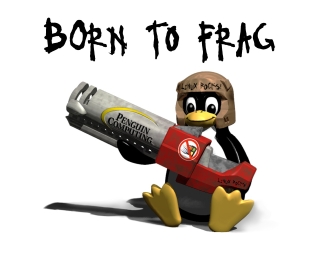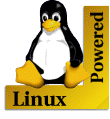 Rich's
Linux Saga
Rich's
Linux Saga
After telling this story as it progressed, I realized that
it would be best to "immortalize" Rich's Linux Saga on the Web, proof to
all that almost anyone can become an obsessed Linux user.
As any good story should start:
"It was a dark and stormy night."
Actually, it was. On May 9, 2000 at about 2am, the home of NT2W was blasted by a direct hit of lightning. Although much of the equipment and antennas were disconnected, my 1996 vintage Pentium 100 PC (along with my original IC706, PK232 multimode, antenna tuner, SWR meter, 2m HT, weather station--the anemometer took the full wrath of the lightning strike--, and a boatload of household items) was rendered useless. Although it powered up, it would not boot, and the noxious odor of burning IC's filled the air, with smoke coming from the I/O area of the motherboard. Truly "toast."
My insurance company essentially valued the "old" PC at next to nothing, and I footed the bill for a new K6-2 machine for the shack. The insurance company was very, very good, replacing or repairing everything, subject to the deductible, of which the PC was part.
Although I scrapped much of the zapped equipment, I kept the old PC, at least for parts for some future project. I did test the hard disk drive in the "slave" position in the K-6 box, and was able to read and write, so it appeared OK.
Fast forward almost two years.
After losing a couple auctions, I bid "high" and won an "as-is" motherboard with P-100 processor (no RAM) for a whopping $5.76. It cost $8.00 to ship!
A few days later the motherboard arrived, and after a couple days' wait, I started disemboweling the old Pentium machine. Within an hour I had the "new" MB installed, some notes made about jumper settings, 32MB of E D O SIMMS and video, sound and modem cards all transplanted.
Now, time for the smoke test. I turned on the switch, and the BIOS setup screen came up... cool... the video card works! I set things up and pretty quickly determined that I had a problem. Although the BIOS could sporadically determine that the drive was there, and the geometry of the drive confirmed, the drive would not boot. Rats. Either I had a flaky motherboard, or the disk drive was no good after all.
Enter the North Country Amateur Radio Club. At the April club meeting, Dan KC2BEZ and Bill N2ZLY brought some junk box assistance in the way of IDE controller cards and a small (400MB) IDE drive. Dan's IDE drive was formatted with a minimal Win95 system, and I installed it in the "master" drive bay, disconnecting my drive. Bingo. Booted up fine. Diagnosis- apparently the lightning strike either fried the "master" jumper circuit or messed up the master boot record. Either way, the drive was not bootable but worked fine as a "slave" to the other drive. $10 later, the 400MB drive was mine for good, and I had a working PC! Whoopee!
While standing by, Bill fanned the nascent flames of my interest in
Linux. Bill is an experienced Linux user, with a knowledge of Unix
from many moons ago. Bill had just successfully installed Slackware
8 in a machine of his and wondered if I'd be interested. Sure.
Here's a great opportunity to learn another operating system... I'll format
the HDD's and install Linux exclusively on this machine and use it as an
experimentation/learning platform. It'll be easy!
Bill burned me a CD of the Slackware 8.0 distro (from here, I'll
start tossing Linux lingo to sound cool), but I cajoled him into downloading
with his cable modem a distro called PeanutLinux (v 9.2), thinking that
I would have to have something that would fit on the 400MB primary master
drive. During my websurfing to find out about Linux, I found
out that Peanut has a reputation of being very compact (150MB image, 350MB
installed), so it would be ideal to start with. Version 9.2 is a
Linux Kernel 2.4 distro.
I armed myself with "Running Linux" from O'Reilly and dug in.
Here begins my transcribed notebook log on the rest of the saga:
4/4/2002
Installed PeanutLinux 9.2. However, could not configure video
for Xwindows. Peanut uses XF86Config v. 4, which did not directly
work with my Trident TGUI video card.
With some help from friend Bill a few days later (cost: 2 Guinness and lunch), XF86Config-4 was set up using driver for VESA (/usr/X11R6/lib/modules/drivers/vesa_drv.o). Although the video acted funky on shutdown, all worked OK. A little fumbling had the mouse set up correctly.
Now with the video supported and mouse setup, I could run X, which is really cool. Now I need sound. Running soundcfg (again a couple days later)was a breeze, and I heard Linus Torvalds' dulcid voice speaking to me in the demo. Success. Almost.
Although it worked while I was using the PC that session, the succeeding reboot put me back to square one audiowise. My PC was mute. I did this a couple times and ended up with no sound, no matter what I tried. I never quite figured it out. On to next problem.
4/13/02
Peanut can be such a small distro partially because it's stripped waaaaaay
down, to the point that it has no print support at all. However,
the Peanut website (see link below) describes very well how to download
and install the Common Unix Printer System (CUPS), which I did successfully.
CUPS printed just fine from Netscape and Kmail (Peanut uses KDE desktop),
but not Kword.. I think it was a version problem.
Meanwhile, I received a distro of TurboLinux Workstation (v 6.0) in the mail that I had ordered at a bargain-basement price from LinuxMall. I liked what I read about Turbo since it was a complete distro with RPM's, source code and a third CD including StarOffice 5.1, which I wanted to run as my office suite. The price of the distro ($10) was worth it just for the office suite (I don't have high speed access and a download would have taken all night, if it went through). Turbo used kernel 2.2 and X 3.6.
4/16/02
Tried to install StarOffice and ran into a problem that was fatal.
I had gotten cute and partitioned my two hard drives into small (300MB
or so) chunks instead of making the 1.5GB drive one big partition.
The result- the Star install filled up any partition I tried.
Back to the drawing board... needed a repartitioning.
4/18/02
As long as I had to repartition anyway, I figured I'd install TurboLinux
instead. It was a full distro complete with a book. Why not?
Well, Turbo did not fix the sound card problem, rendering my machine mute
again. No big deal. Also installed StarOffice.
4/21/02
Determined I could not run kppp (dialup program) as anyone other
than Root. Need to learn more about that, but meantime, I'll just
open a terminal window as Root and run the program (thanks Dan for the
suggestion)
4/26/02
Still not able to get the machine to print. Configuring is seemingly
an easy process, but does not work. I do a Google search on TurboLinux
print problems and find out in the turbo users forum that printing is potentially
very hairy with this distro. Great.
The suggestion is to use APS and Ghostscript (hey- got that with CUPS!). Could not get Ghostscript to work. It needed libpng.so.3, and Turbo did not have this library. I downloaded, but could not get anything to work. Drat.
In the meantime, I had purchased the "Linux for Dummies" book, since I figured it was fitting after three weeks. It just so happened that LFD had included a three-disk distro of RedHat 7.0. Why not?
4/30/02
After taking a breather, I cleared the deck and installed RH 7.0 (kernel
2.2). Of course this couldn't be a snap. It installed, but
couldn't get X working. It appeared that XF86Config was broken.
Interestingly, the documentation said that RH7 shipped with XF86Config 4, similar to Peanut. However, watching things run it really was running 3.6 like Turbo. Problem in the config file... hmmmm..
Looking at the errorlog from running X, it was having a problem reading XF86Config. For some reason, the autoconfig included with RH omitted an EndofSection line in the display section of the file. Only took me two days to find that one!!!!
5/2/02
Successfully installed print services. This RedHat is much easier
for a newbie to navigate through! Have to admit the Dummies book
helps!
5/8/02
Friend John NS2P had given me a genuine Soundblaster card to replace
the troublesome non-compliant card I had tried now with three different
distro's. Certainly the SB16 card would be supported. Sure
enough, the magic sound reappeared and all was good!!! Success at
last.
I'll just go online (yes, kppp still requires me to be root) and download my email before I turn in for the night.
WHERE'D MY MODEM GO??!!!!
Kppp now says that my modem is busy! I have an uneasy sinking feeling. I smell an IRQ problem. I am right.
Unfortunately, this is not a simple fix. I grope around the /proc/interrupts list and the /etc/modules.conf files, but I'm just lost. And disgusted.
5/19/02
What the heck. I removed the soundblaster card and put
the original sound card in and changed some BIOS settings to support
a PNP aware operating system. Disaster. At this point,
it messed up my mouse so it made X useless. Ugh. Even upon
removing all plug and play cards (sound and modem) could not find the mouse.
I was near quitting.
5/21/02
Complete reinstall of Red Hat Linux with the Soundblaster installed.
The system could not find the mouse or modem. Didn't even bother
with the sound. Time for a vacation.
5/29/02
Tried configuring the BIOS to assign IRQ's 3,4 and 9 to ISA.
Set the modem via jumpers (non-PNP) to IRQ 9 Com4. Still didn't
find the modem. Also, set mouse to TTYS0 and it was FOUND Successfully
installed the SB card. Partial success. Also installed
another 32MB of SIMMS, compliments of my friend Doc W2IB.
6/1/02
Bill came over again (yes more beer and pizza this time). On
5/19 I had set BIOS to "PNP Aware OS." Linux seemed
to be setup OK... I could edit isapnp.conf to change IRQ and address
for modem (now set back to PNP), but it could not be found.
Ultimately edited isapnp.conf to comment out the modem card completely from the file, setup Soundblaster as IRQ 5 and standard address settings (also edited modules.conf to correct settings), and then (in hindsight most important) changed my BIOS to NOT PNP aware. For some funky reason, the BIOS now sees THREE serial ports instead of two with the PNP enabled. One of them is the MODEM.
On bootup, RH runs kudzu and finds the modem card for the first time. It configures to TTYS0, making the mouse TTYS1.
SUCCESS! I now have a working, multimedia, online Penguin-Powered Linux box!!! Despite the trials and tribulations, I really enjoy it, and it's working nicely- I did it! And boy, did I learn about Linux!
Total invested: $25.00 (includes postal money order and a stamp)
Weird- my PC has two serial ports on the motherboard, com1
and com2 just like most PC's. The mouse is on com1 and com2 is not
hooked to anything. In my notes, I noted that when I ran
Peanut the mouse was ttys1 and the modem ttys0 which corresponds to com2
for the mouse and com1 for the modem. The hardware port on the motherboard
now shows up as com4! Haven't tried it out.
It's just weird that HARDWARE ports com1 and com2 have been respectively reassigned as devices ttys1 and ttys3 in Linux. I never would have guessed it.
Many thanks to all who've watched me devolve into a sleep-deprived lunatic (but I've gotten better!). Special thanks to Bill, Dan, John and Doc, who have contributed time and equipment to support my habit, and put up with endless stories and questions!
Perhaps you, too, should try Linux...
PHEAR THE PENGUIN!!

 Bill the Borg (thanks to
slashdot.com)
Bill the Borg (thanks to
slashdot.com)
www.linux.org - great set of
links for Linux users
www.redhat.com - Red Hat, the Linux
I'm currently running
www.linuxnewbie.org - a new-user-friendly
Linux site
www.ibiblio.org/peanut
- home of PeanutLinux
